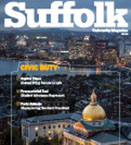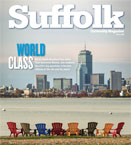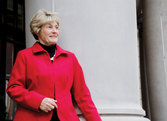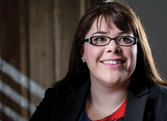Thinking Small, Living Large
NESAD students customize mini urban dwellings.
"We have a word for microhousing in New York,” Suffolk University President (and former Manhattan denizen) James McCarthy told the crowd in his opening remarks at Boston’s Modern Theatre. “It’s called an apartment.”
The topic, “Micro-housing: Rethinking Urban Living,” was the third in a series called Building Boston 2030, co-sponsored by Sawyer Business School and the Greater Boston Real Estate Board. The concept behind these tiny apartments, some as small as 300 square feet, is to use highly efficient design to make urban living accessible to populations that might otherwise not be able to afford it.
In Boston, it is “a market response to what the mayor challenged us all to do,” says panelist Kairos Shen, director of planning at the Boston Redevelopment Authority. Shen noted that about a third of residents are 21 to 34 years old, a group the city hopes to retain post-college. Kelly Saito, president of the Gerding Edlen real estate firm and another panel member, believes “the key is the location,” citing access to public transportation and employers among the benefits of these relatively affordable apartments. “We think it’s a necessity,” said panelist Michael Glass, a human resources specialist with Vertex Pharmaceuticals. Panelist and architect urban designer Tamara Roy, senior associate principal at ADD Inc., said, “This feels so much bigger than 300 square feet,” a point underscored by a walk-through of a full-scale model constructed at the Modern.
Price and amenities are important, “but also lifestyle,” added the final panelist, Karen Clarke, program co-director of interior design at the New England School of Art & Design (NESAD). Eight NESAD students, Sonya Randell ’13, Shahrzad Abtahi ’14, Rebecca Rivers ’13, Lindsay Bach ’14, Hisham El Bassiouni ’13, Vandana Sharma ’13, Tzesika Iliovits ’14, and Yishuan Wu ’13, were challenged with the question, “How can we live better in less space?” They responded by creating four prototype styles for master’s program and from their IKEA furniture set” to something more refined, “The Hunter” features “premium finishes, natural light, integrated technology, and clean, modern lines.” And for those who are “city-proud” with “sophisticated taste” and the desire to live “within a small footprint,” there is “Eco-Cosmopolitan.”
Working with NESAD Associate Professor Anna Gitelman, the student designers’ interpretations make micro-housing as desirable as it is attainable. “a personal space that, despite its smaller size, doesn’t feel like a compromise.” The first, “Spirited,” boasts 10-foot ceilings and sustainable refurbished furniture to create a stylish interior. “Creator” provides “a blank canvas” for “an intellectual, an artist, a nonconformist” to design a space reflecting “the character, aesthetic, and creativity of its resident.” For those who have “graduated from their master's program and from their IKEA furniture set" to something more refined, "The Hunter" features "premium finishes, natural light, integrated technology, and clean, modern lines." And for those who are "city-proud" with "sophisticated taste" and the desire to live "within a small footprint," there is "Eco-Cosmopolitan." Working with NESAD Associate Professor Anna Gitelman, the student designers' interpretations make micro-housing as desirable as it is attainable.










